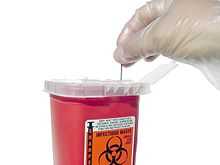Sharps container

A sharps container is a container that is filled with used medical needles (and other sharp medical instruments, such as an IV catheter). They fit into two main types:
- single use which are disposed of with the waste inside,
- reusable which are robotically emptied and sterilised before being returned for re-use.
It is standard practice in developed and even underdeveloped countries for used needles to be placed immediately into a sharps container after a single use, with only a few exceptions to the general rule. Sharing needles is often the cause of AIDS (HIV) and other blood-borne infections spreading among intravenous drug users.
Needles are dropped into the container without touching the outside of the container. Needles should never be pushed or forced into the container, as damage to the container and/or needlestick injuries may result. In most countries around the world, recapping and de-notching needles is also no longer accepted practice.
Proper use of a sharps container includes pick up by or delivery to an approved "red bag" or medical waste treatment site. In addition to this pre-existing safety measure, all U.S. medical and educational staff are federally required to be tested on their knowledge of bloodborne pathogens.
The most common sharps containers (red plastic in the US, yellow plastic elsewhere) were first developed in 1979 when Frontier Plastics Ltd of South Wales in the UK recognized the need for a purpose designed container for the safe disposal of clinical sharps - developing the original Sharpsafe container which was first marketed in 1980.
During the last ten years, increased worldwide focus on safety and environmental impact has led to several positive government mandates being issued regarding engineered medical device standards and the reduction of clinical waste output from health facilities. This has resulted in a move toward reusable containers with built-in safety devices such as trays and locking devices. An example of this type is the Sharpsmart system, developed by Daniels Sharpsmart in 1986 and now used around the world.
In the United States, sharps disposal regulations differ in each state.
See also
- Needle remover
- Needle-exchange programme